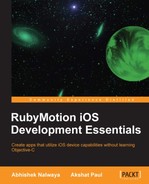Congratulations, we have covered a lot in the last 11 chapters and we are sure you now know a lot more about RubyMotion than you did at the outset.
We have learned a lot of things during this journey—beginning with installing RubyMotion, understanding the RubyMotion folder structure, debugging our application, introducing RubyMotion objects, creating an MVC application, playing with the user interface, using device capabilities such as the camera, gestures, persistence storage, writing test cases, creating games, using RubyMotion-flavored gems, and submitting the application to App Store. That's a lot of stuff!
So, what can be done next from here? The answer to this question is plenty of things! There is still a lot to discover in RubyMotion and the iOS SDK; so from here, the first thing we can do is grab a book that explores the iOS SDK in detail. The best source for anything related to iOS SDK is Apple's Developer Reference at https://developer.apple.com/. All things at Apple's Developer Reference are in Objective-C, but now we have the skills to translate verbose Objective-C code to learn and clean RubyMotion code.
Next, keep yourself updated with the latest happenings in the RubyMotion ecosystem with the RubyMotion blog (http://blog.rubymotion.com) and Developer Center (http://www.rubymotion.com/developer-center/). The RubyMotion blog keeps us updated with the RubyMotion world—what's new in this version or what's in store for the future of RubyMotion. Developer Center is a great source for API references, some quick tutorials, and the latest articles on technology. For RubyMotion wrappers and libraries, you can visit http://rubymotion-wrappers.com/. This web page is a one-stop shop for details on available wrappers and is updated often.
To discuss any issue, you must join the RubyMotion community at its Google group (https://groups.google.com/forum/?fromgroups#!forum/rubymotion). This group is a great place to interact with the vibrant RubyMotion community.
Finally, create apps! There is no better way to master a technology than learning on your own in a real-world scenario. You can contribute to the community by creating wrappers and gems—that's a great way to acquire expertise on a specific area of a technology. We hope you have enjoyed reading and learning with this book, and have now evolved as an iOS RubyMotion developer; we are very excited about RubyMotion, just like you, and look forward to seeing your work making a mark in the iOS and RubyMotion world.
